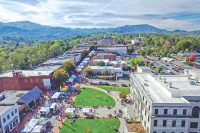Best of the burden: Smokies mules make backcountry operations possible
 A member of the mule team waits patiently as Danny Gibson moves in the background to assess the load to be transported. Holly Kays photo
A member of the mule team waits patiently as Danny Gibson moves in the background to assess the load to be transported. Holly Kays photo
In popular culture mules get a bad rap, cast as stubborn, ornery and even mischievous.
But Danny Gibson, animal packer for the Great Smoky Mountains National Park, spends more time with mules than just about anybody around, and he’s quick to jump to their defense.
“They have that notorious reputation of being stubborn, but they’re not really stubborn — they just don’t want to get hurt,” said Gibson. “It’s self-preservation. If it doesn’t look safe, a horse will just walk over it, but a mule’s like, ‘Eh, I don’t know about that.’ They are thinkers.”
‘Unsung heroes’
The six mules tethered to a gate at the Smokies’ Rainbow Falls Trailhead backed up Gibson’s words. Perhaps it’s because they were deep in thought, but they didn’t come across as ornery at all. Rather, they stood perfectly still, emptied saddles patiently awaiting the next load of locust logs to be carried a challenging 2.7 miles to Rainbow Falls.
“They’re definitely the unsung heroes of the park,” said Gibson, gesturing toward his team.
Related Items
Each mule weighs about 1,200 pounds and is capable of walking for miles with 250 pounds on its back — for a team of six mules, that’s 1,500 pounds per trip, carried over some of the most difficult terrain in the park. Today’s goal, Rainbow Falls, will require ascending some 1,500 feet along 2.7 miles of trail in conditions ranging from impeccable to deplorable. The logs are to be delivered as part of a two-year rehabilitation project on Rainbow Falls Trail through the Trails Forever Program, and while some sections have already been renovated to perfection, others are full of rocks, roots and gullies.
“Mules are great animals. They’re real agile, and we get into some rough places,” said Gibson. “If I think they’re going to get hurt I wouldn’t take them in there, but they’re like, ‘This ain’t nothing.’”
Gibson’s enthusiasm for his mules is obvious, as he pours out unprompted praise of their intellect, athleticism, stamina and general good sense.
“You have mule wrecks sometimes. The great thing about a mule is when he gets in a position he falls or gets hung up, he doesn’t get in a fight (like a horse),” he said. “The mule will kind of go into a trance like, ‘I’m stuck. You come help me.’ It does happen, but it’s rare you get one hurt.”
By 10:30 a.m., the team had already been up to Rainbow Falls and back once, dropping 12 locust logs, some weighing upwards of 100 pounds, at the top before descending to repack for a second delivery. Gibson and his assistant Daniel Allen tied the mules up at the gate and prepared their packs — identical wooden v-shapes reinforced with steel and hung with bright orange ratchet straps — to receive the load.
“Locust are some of the hardest items to haul in, because they’re not uniform shape, and as you’re moving they’re moving too,” said Gibson. “So you have to keep tightening down so you don’t loosen up the ratchet straps.”
Packing up the mules is an expressly physical task, with Gibson and Allen working in concert to lift each log, carry it to the saddle of the appropriate mule, and nestle it into place. Different logs are different shapes and sizes, and Gibson examined each specimen carefully, working to determine where it would best fit to leave the mule with a comfortably balanced load.

Danny Gibson (left) and his assistant Daniel Allen lift locust logs to give the mules a balanced and comfortable load. Holly Kays photo
Eventually, all 18 logs for the second run were packed away and it was time to move. Gibson mounted his horse — mules are the product of a horse mother and a donkey father, so following along behind a horse comes naturally to them, Gibson explained — and the team set off up the trail.
Even fully loaded, mules travel at about 3 miles an hour, which is faster than most people hike — especially up a steep trail like Rainbow Falls — so before long mules disappeared from sight, and the clatter of hooves on rock and the shuffle of slightly shifting logs and saddles faded into the distance. The team would stop once or twice to adjust loads or take a quick breather, but mostly they would just keep going, steadily marching on until meeting their destination.
‘It’s all about the mules’
Of the Great Smoky Mountains National Park’s 11 million annual visitors, very few will ever encounter a passel of pack mules while out hiking the trails, but most will — though unknowingly — reap the benefits of the animals’ hard work.
Trail work in the park is done by hand, no motorized equipment allowed. And while a combination of creativity and skilled labor is usually enough to get the job done, sometimes the park’s human workers find themselves outmatched. It took the mules mere hours to move 30 logs from the parking lot to the falls, but a trail crew would have needed days to do the same. And when it comes to even bigger materials, like the 50-foot-long logs used to build stream crossings, even a team of exceptionally burly humans would have a hard time making much progress.
Because of the mules, “We can do so many things we wouldn’t be able to do otherwise, not only for trails but also for backcountry,” said Trails Forever crew leader Josh Shapiro.
“It’s pretty phenomenal,” agreed park spokesperson Dana Soehn.
The mule teams haul in bear boxes to keep trail crews’ food safe. They carry food storage cables for backcountry campsites, doors and windows for structure rehabilitation projects, trail crews’ toolboxes and water supplies, equipment for wildlife staff — basically, anything heavy or exceptionally cumbersome that needs to make it in or out of the backcountry.
“We pack in a lot of stuff for the backcountry,” said Gibson. “Fire rings, mulch for the privies. Fisheries, wildlife, about every division at some point we’ve helped out. And in search and rescues, we’ve helped with mules.”
Mostly, though, the packing program supports the trails division.
The program’s importance to park operations is undeniable when looking through a laundry list of statistics compiled from data gathered between 2009 and 2016. During that time, horses and mules were used for a total of 418 days and an average of 9.5 hours each day used, with 351 days spent working for the trails division and 67 working for other groups. Stock covered 2,615 miles of trail while packing and cleared 2,672 miles of trail and 4,950 trees. They pulled 11 footlogs measuring between 25 and 52 feet and weighing 1,600 to 4,500 pounds. They packed in an estimated 252,850 pounds of equipment and participated in five search and rescues, recovering one body.
“It’s all about the mules, because they’re the ones who do the job,” said Gibson.
The mules may be the ones hauling giant logs, but Gibson is always right there with them — sometimes atop a horse, a vantage point that allows him to better watch over his team and spot any problems with their loads, and sometimes on foot. The only year-round employee in the stock program, Gibson is the person on whom the mules’ welfare ultimately depends.
For the mules, that’s a shot of luck. Spend a few minutes with Gibson and his beasts of burden, and it’s clear they have a bond — they’re more than just coworkers. While Gibson grew up around livestock, he said, “I didn’t mess around with mules till I came here.” But as a former K9 officer, he arrived well versed in the ways of animals, and what it takes to have a solid working relationship with one.
“It’s remarkable how much a German shepherd and a mule has in common,” he said.
In both cases, the handler’s first job is to earn the animal’s trust. Then, when the animal refuses to do something it’s being told to do, the handler must figure out what the problem is and then fix that problem, convincing the animal that the task is now safe to do. You can never make a mule do something, Gibson said. You can only ever persuade it, baby step by baby step.
“You just have to get them out there and let them get used to it,” he said. “If they don’t like it, you don’t just say, ‘Oh, he don’t like it. I’ll put him in the barn.’ Enough times he gets brushed by a limb or whatever, he’ll get used to it. All of em’s good mules. It’s because we use them. They don’t stay in a barn all the time. We use them during the summer three or four days a week.”
Packing and The Wilderness Act
Gibson is only the second animal packer the park’s ever had. The program was founded in 1976, with Sonny Freshour hired to do the job. He stayed there for more than 30 years, retiring in 2010. Gibson, who began working for the park in 2003 as a trail crew member, joined Freshour in the barn a couple years later, where he trained for three-and-a-half years to learn the ins and outs of mule packing before Freshour retirement.
“When he retired I just stepped up to it,” said Gibson. “He was a good trainer.”
The packing program came about as the result of a piece of federal legislation that’s important for many other reasons, as well — the Wilderness Act of 1964. The act aims to set aside pieces of exceptionally beautiful and pristine land for permanent preservation, severely limiting the activities that can take place there in hopes of creating “an area where the earth and its community of life are untrammeled by man, where man himself is a visitor who does not remain.”
While the park was never named an official wilderness area, in 1974 then-Secretary of the Interior Bob Herbst recommended that Congress designate 390,500 of the park’s 522,427 acres as wilderness. The recommendation was never approved, but it triggered the park to begin managing the acres as though they were, in fact, wilderness.

Following a series of rainy days, the mule team crosses below Rainbow Falls. Following a series of rainy days, the mule team crosses below Rainbow Falls. Josh Shapiro photo
“The only roads we could use were administrative roads that were outside that wilderness area,” Gibson explained. “When they started closing it down these crews were saying, ‘How are we going to get some of these materials and supplies here that we need?’”
Eventually, someone suggested mules. Freshour was hired, and the rest is history. At one point, the park had two mule barns — one in Cades Cove and the other in Towstring, near Cherokee — but currently the entire stock program is run out of Towstring.
The Smokies is the only park in the eastern U.S. to use mules for backcountry work. While the C&O Canal National Historical Park in Maryland has mules, those animals are used primarily for historical reenactment purposes, not for backcountry transport.
According to Gibson, it’s worked out well for the Smokies mules, because the life they’re living suits them just fine.
“Mules enjoy working,” he said. “They’ll tell you when you’re loading them too heavy. A lot of times when you tighten their saddle too heavy they’ll look over at you like, ‘That’s enough.’ They’ll give you little hints about how they feel.”
It’s just up to Gibson to listen.
By the numbers
The Great Smoky Mountains National Park’s packing program has made its mark on park operations over the years, as shown by these data compiled between 2009 and 2016.
- Days used: 418
- Hours used: 3,987
- Miles of trail covered while packing: 2,615
- Weight of packed equipment: 252,850 pounds
- Miles of trail cleared: 2,672
- Number of trees cleared: 4,950
- Footlogs pulled: 11
- Weight of footlogs: 1,600 to 4,500 pounds
- Search and rescue events: 5
Learn more
Be sure to pick up The Smoky Mountain News next week to learn more about the two-year Rainbow Falls Trail rehabilitation project. The mule team’s contribution is indispensible, but there are many others working hard to get the trail up to snuff for future visitors.









